A popular trend among some Orientalists is to try and attack the Qur’ān by casting doubt on its historical reliability. What should we as Muslims make of these claims? It is important to understand the way historians view history. Much like detectives, they work by piecing together clues that they find in the present to form a bigger picture about something that happened in the past. The clues can vary from archaeological evidence to testimonies of those who lived during, or close to, a particular historical person or event. Motives must be sought, sometimes even second guessed. Therefore much like a jigsaw, the more pieces of the puzzle they have, the clearer and more complete the picture of the past will be. The further back in history one goes, the more difficult this task becomes, as there are fewer pieces of the jigsaw that have survived.
Historians are limited in what they can discover about the past because they can only deal with what is apparent. A good example of this is the late Mother Teresa. She was a Roman Catholic nun who dedicated her life to the poor, sick and dying in India. Such was her dedication to charitable work that she has been dubbed the Saint of the Poor. She was the recipient of numerous honours including the 1979 Nobel Peace Prize. In 2003, she was beatified by the Catholic Church as “Blessed Teresa of Calcutta”. It is believed that she will soon be officially recognised as a saint by the Catholic Church. For a long time historians held her as an exemplary of piety. No credible historian questioned her faith because of what was apparent, everyone judged her by her public persona.
All of this changed ten years after her death with the release of some of her private letters.[1] They revealed for the first time that throughout her life she was deeply tormented about her faith and suffered periods of doubt about God. This stands in marked contrast to her public image as a selfless and tireless minister for the poor who was driven by faith. Literally overnight she went from being the Saint of the Poor to a doubting Thomas. Because these letters were kept secret by her colleagues and seniors, historians held to a distorted picture of her even long after her death. What this example serves to demonstrate is that the reality of a situation can, and often is, at odds with what human beings are able to perceive using our limited senses.
By contrast the Qur’ān is not limited by the apparent; it in fact reveals the reality of history. The Qur’ān proclaims that it reveals knowledge of the unseen:
That is from the news of the unseen which We reveal to you, [O Muḥammad]. You knew it not, neither you nor your people before this… [2]
This quality is illustrated beautifully in the story of Prophet Ibrāhīm (ʿalayhi al-Salām). The oldest historical accounts we have for Ibrāhīm are found in the Old Testament. Biblical tradition places Ibrāhīm’s birthplace to be a location called “Ur of the Chaldeans”:
This is the account of Terah’s family line. Terah became the father of Abram, Nahor and Haran. And Haran became the father of Lot. While his father Terah was still alive, Haran died in Ur of the Chaldeans, in the land of his birth. [3]
Ur was an ancient city of Mesopotamia located in modern day Iraq.
Image may be NSFW.
Clik here to view.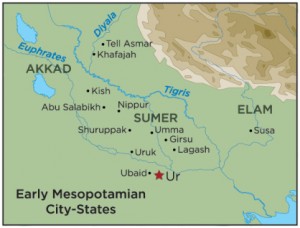
The Bible states that Ibrāhīm’s people were idol worshippers. It must be noted that the Bible makes no mention of specific idols that were worshipped, they are simply referred to as “other gods”:
Joshua said to all the people, “This is what the Lord, the God of Israel, says: ‘Long ago your ancestors, including Terah the father of Abraham and Nahor, lived beyond the Euphrates River and worshiped other gods.'” [4]
While there is a lot of overlap in the stories about Ibrāhīm in the Qur’ān and Bible, there is a particular story about Ibrāhīm that is only found in the Qur’an:
And thus did We show Abraham the realm of the heavens and the earth that he would be among the certain [in faith].
So when the night covered him [with darkness], he saw a star. He said, “This is my lord.” But when it set, he said, “I like not those that disappear.”
And when he saw the moon rising, he said, “This is my lord.” But when it set, he said, “Unless my Lord guides me, I will surely be among the people gone astray.”
And when he saw the sun rising, he said, “This is my lord; this is greater.” But when it set, he said, “O my people, indeed I am free from what you associate with Allāh.
Indeed, I have turned my face toward He who created the heavens and the earth, inclining toward truth, and I am not of those who associate others with Allāh.” [5]
We can see from this story how Ibrahim debated with his people, explaining to them the error of their way in worshipping false gods. We are taught an important principle by this story; we should only worship that which is worthy. Even though the sun, moon and stars are attractive, ultimately they are part of the creation which means they have a creator and therefore one that is more worthy of our worship than they are. Like the Biblical narrative, the Qur’ān states that Ibrāhīm’s people worshipped idols. However unlike the Bible, the Qur’ān goes into historical detail as it elaborates on the idolatry of his people.
There is strong evidence to suggest that the star spoken of in the Qur’ān is in fact Venus. We find mention of this in the works of Tafāsīr of several classical scholars of the Qur’ān. For example from Tafsīr al-Jalalayn:
“When night descended, [when] it darkened, upon him he saw a star — said to have been Venus…”
From Tafsīr Ibn Kathīr:
“Ibrāhīm, may Allāh’s peace and blessings be on him, first proved that Venus is not worthy of being worshipped…”
That the celestial body mentioned by the Qur’ān is Venus can also be deduced from astronomy. Let us analyse the verses in detail:
So when the night covered him [with darkness], he saw a star. He said, “This is my lord.” But when it set, he said, “I like not those that disappear.” [6]
Venus plays a very prominent role in the night sky. Venus is the brightest planet in sky, but it is only visible shortly after sunset or before sunrise. Notice the words of the verse, “I like not those that disappear”. Venus is in fact known as the “Morning Star” and “Evening Star” because it is visible for only a short amount of time just after sunset and again for a short amount of time just before sunrise. From the verse itself we can see that the star disappeared just after night fall. Furthermore, the very next verse tells us that the Moon rose after the disappearance of the star:
“And when he saw the moon rising…”
Again this would indicate that the celestial body is Venus. Even from a logical standpoint, if his people did worship the celestial bodies then they would surely worship the most prominent ones. It so happens that Venus is the third brightest object in the sky, after the Sun and Moon, sometimes appearing so bright that it can actually cast shadows on the ground. In summary, the Qur’ān alludes to the claim that Ibrāhīm’s people worshipped three celestial gods: the Sun, the Moon and Venus.
Does archaeology support the Qur’ān’s claims? Ibrāhīm’s city, Ur, was founded around 4000 BC and was the capital of the Sumerian civilisation and once a great harbour city on the banks of the Euphrates River. The city started to decline from around 550 BC and was no longer inhabited after about 500 BC. Eventually the city fell into ruin and the area was buried beneath the desert sands.[7] Before the 20th century, written history had told the world very little about Ur. Beyond the Bible’s brief references to it as the home of Ibrāhīm, almost nothing was known. The British Museum commenced excavations in Ur under the direction of archaeologists in 1918. They were forced to dig a vast hole over 40ft deep to uncover the lowest levels of the city. Their findings revealed much about everyday life, art, architecture, literature, government, and religion in what has come to be called “the cradle of civilisation”.[8]
They discovered that Ur was especially devoted to the worship of the Moon god Nanna. Here is the Ziggurat of Ur, a giant complex containing a temple dedicated to Nanna, the principle deity of the city [9]:
Image may be NSFW.
Clik here to view.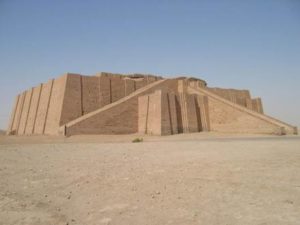
Here is a relic discovered at Ur which depicts the moon god Nanna in the form of a crescent:
Image may be NSFW.
Clik here to view.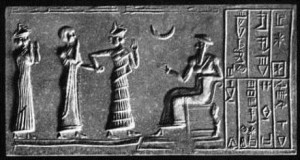
The people of Ur also worshipped other astral gods and goddesses. This bronze figure represents Ur-Nammu, the ruler of Ur. The inscription around and over the king’s body states that Ur-Nammu dedicated the figure to the goddess of Venus, Ishtar [10]:
Image may be NSFW.
Clik here to view.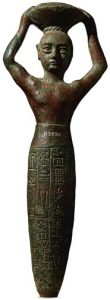
The people of this region also worshipped the sun. In this stele the sun god Shamash, god of justice, is depicted handing authority to the king. If you look closely at the figure on the right you see sun rays proceeding from his shoulders [11]:
Image may be NSFW.
Clik here to view.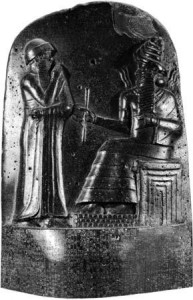
In fact these three astral deities – Nanna (the Moon god), Shamash (the Sun god) and Ishtar (goddess Venus) – were believed to be genealogically related to each other and formed an astral triad. According to Sumerian mythology, Ishtar and Shamash were siblings and both the offspring of the moon god Nanna [12].
The famous Stele of Ur-Nammu depicts this relationship between the Moon god Nanna joined together with his daughter Ishtar the goddess of Venus:
Image may be NSFW.
Clik here to view.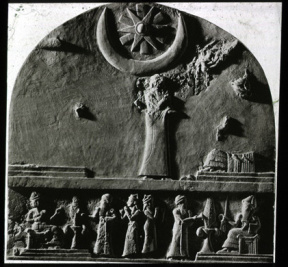
A lot of the relics from this period of Sumerian history have been lost or destroyed. Later surviving relics depict the astral triad together in full:
Image may be NSFW.
Clik here to view.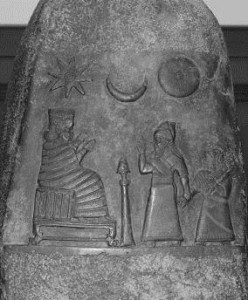
Here is an example of a boundary stone. It portrays numerous Mesopotamian gods graphically in segmented registers on the stone. Notice how the astral triad of Venus, the Moon and the Sun take their place at the top of the pantheon of gods, signifying their prominence:
Image may be NSFW.
Clik here to view.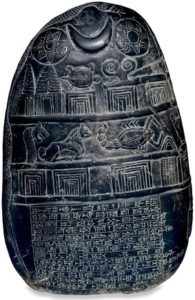
What is remarkable is that this knowledge had been lost for thousands of years at the time of the Qur’ān’s revelation in the 7th century. These historical claims that have been mentioned in the Qur’ān about the deities worshipped by Prophet Ibrāhīm’s people – the astral triad of the Sun, Moon and Venus – could not have naturally been known to Prophet Muḥammad (sall Allāhu ʿalayhi wa sallam). Knowledge of Sumerian religion (especially the birthplace of Ibrāhīm, the city of Ur) had been lost for thousands of years until their rediscovery and excavation in the 20th century.
The only realistic natural source of knowledge about Ibrāhīm available to Prophet Muḥammad (sall Allāhu ʿalayhi wa sallam) would have been the Bible based stories in circulation. As we have seen however, the story of Prophet Ibrāhīm in the Bible is silent on the details of the religious beliefs of his people. Critics may claim that the author of the Qur’ān merely luckily guessed the gods and goddesses that were worshipped by Ibrāhīm’s people. This is highly unlikely given the fact that the people across this region worshipped thousands of deities. They had gods for everything from brick making to brewing, even including a Lord of Livestock Pens.[13] From where then did Prophet Muḥammad obtain this information? The Qur’ān answers:
Your Companion is neither astray nor being misled. Nor does he say (aught) of (his own) desire. It is no less than inspiration sent down to him. He was taught by one mighty in Power. [14]
We have looked at one example in detail, the story of Ibrāhīm. However the author of the Qur’ān consistently demonstrates knowledge of the unseen, of different times and places in history. This is not a quality of fallible human beings but rather the divine. This is one of the many reasons why we have certainty in the perfect words of our Lord. Allāh is the knower of the unseen, His knowledge trumps all human knowledge. So if there ever is an apparent conflict between historians and the Qur’ān, we can rest assured that the Qur’ān goes beyond what is apparent and reveals the true reality of the situation:
This is the Scripture in which there is no doubt, containing guidance for those who are mindful of God… [15]
Source: www.islam21c.com
Notes:
Further Reading
For a more in-depth treatment of various subjects covered in this article you can refer to the author’s blog:
http://manyprophetsonemessage.com/2014/10/14/quran-reveals-lost-knowledge-about-prophet-abraham/
References
[1] Reuters article (valid as of 02/08/2015):http://www.reuters.com/article/2007/08/24/us-teresa-letters-idUSN2435506020070824
[2] Al-Qur’ān 11:49 [3] Genesis 11:7-28 [4] Joshua 24:2 [5] Al-Qur’ān 6:75-79 [6] Al-Qur’ān 7:76 [7] British Museum website (valid as of 02/08/2015):http://www.britishmuseum.org/explore/highlights/articles/u/ur.aspx
[8] Pennsylvania Museum website (valid as of 02/08/2015): [9] Charles Kahn, World History: Societies of the Past. [10] British Museum website (valid as of 02/08/2015): [11] Louvre website (valid as of 02/08/2015):http://www.louvre.fr/en/oeuvre-notices/law-code-hammurabi-king-babylon
[12] Kramer, Sumerian Mythology. [13] Robert Wright, The Evolution of God. [14] Al-Qur’ān 53:2-5 [15] Al-Qur’ān 2:2The post Unveiling History: The Qur’an’s Remarkable Insight into the Past appeared first on Islam21c.